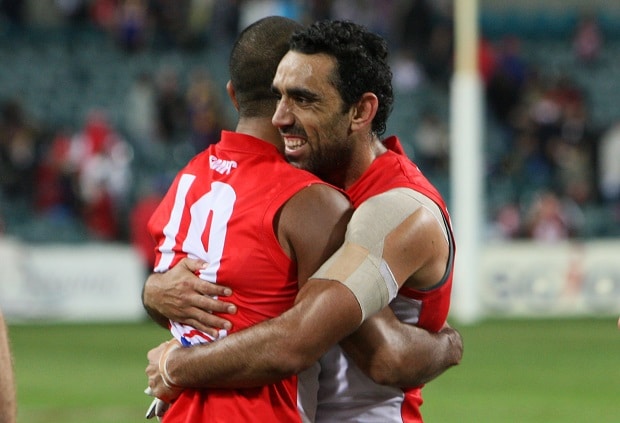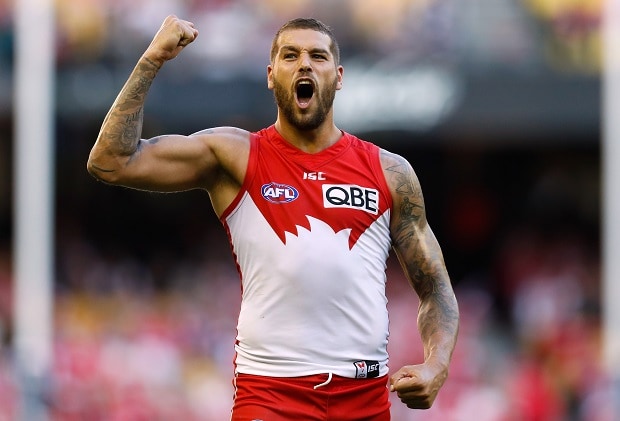It was made of possum skin or from the hide of another furry critter found in the Australian sun-kissed scrub.
It was soft on the foot, thanks to its sheath, but stuffed as to ensure it was firm and strong enough to hold its form when bounced off the branches, rocks and dirt of the western plains of Victoria, where it is known this Indigenous past time began.
But the aim of the game was for it to not hit the ground.
You kicked it, unlike the white man who threw theirs, and you drew on your innate ability to leap through the air, sometimes five-foot high, to bring it down amid cries of catch or “mumarki.” The one who kicked it the highest was judged the best, and then bestowed the honour of burying it the earth until next time.
Onlookers – family and tribesmen – often cheered on the men and boys who graced the playing field with this supreme athleticism. All in an afternoon’s work, really.
It was their game and they played it their way because they were naturals after all. It was like they were born to play.
It was called “Marn Grook” in Gunditjmara language, or “game ball” when the alphabet eventually arrived on Australian shores.
With the arrival of Australian Rules’ football, thanks to Tom Wills, the term Marn Grook was lost in translation for a period before the evidence re-emerged and the link strengthened.
It was our Indigenous footballers, both past and present, who brought it back into the limelight.
Fitzroy’s Joe Johnson helped lay the foundations. He’s recognised as the first ever Indigenous footballer to play in the VFL.
Some 178 footballers with Indigenous heritage have followed.

Two greats of the modern era - Adam Goodes and Michael O'Loughlin.
Don Keyter was South Melbourne’s first.
The story goes that Keyter arrived in the northern Victorian town of Merbein on the back of a picker’s train for the local grape harvest.
Someone, probably an official or a supporter from the local footy club, asked whether the newcomer could play. He said no but they didn’t take no for an answer and threw him a pair of boots anyway.
The rest, as they say, is history.
Keyter’s raw but very real talents opened the door to an 86-game career for South Melbourne between 1953 and 1958. He was originally recruited as a ruckman but was often, with varying results, tried as a key forward to help fill South’s goal-kicking woes.
He was best described as a tough and selfless footballer, a “tireless battler” as The Argus newspaper aptly reported in 1958. He possessed one of the worst kicks in the VFL, a flaw repeatedly echoed in the local press, but worked hard at his development.
He revealed to Tiger-turned-commentator Jack Dyer on radio that he’d train on Tuesdays and Thursday and then spend nearly every other week night back at Lake Oval by himself to master that shonky right boot.
The Sydney Swans/South Melbourne Football Club this week remembers Don Keyter not for his suspect kicking but for being a trailblazer for every Indigenous footballer who has since donned the red and white or any other football jumper for that matter.
It was blokes like Keyter, then Elkin Reilly (1962-66) and then Rueben Cooper (1969), as far as South Melbourne was concerned, who broke down barriers and paved the way for today’s heroes to play the game they were evidently born to play.

Lance Franklin has thrilled Sydney Swans supporters for the past four seasons.
In all, 18 players from Aboriginal and Torres Strait Island descent have represented the football club.
The list includes a host of household and not-so-well-known names, each of them equally important members of the AFL community.
It includes players with only one senior game to their names like Brian Stanislaus (1991) and Byron Sumner (2011).
It includes players who forged incredible careers, Adam Goodes (1999-2015) and Michael O’Loughlin (1995-2002) topping that list.
It includes players cut short in their prime like Jamie Lawson (1991-1994), who had to give the game away due to compartment syndrome stemming from a broken leg, and players who rode the wave that was Sydney’s formative and darker years like Derek Kickett (1994-96), Troy Cook (1997-99), Robbie Ahmet (1998-2001).
Tonight, our Indigenous heroes, past and present, take centre stage in the 14th edition of Marn Grook, an event strongly connected with the AFL’s Sir Doug Nicholls Indigenous Round.
It’s our time to celebrate their enormous contribution to the game and their time to thrill us in a game they were born to play.



